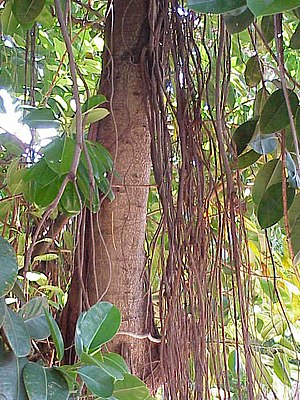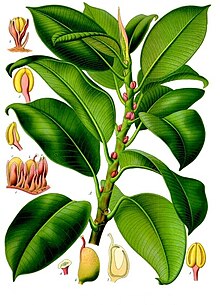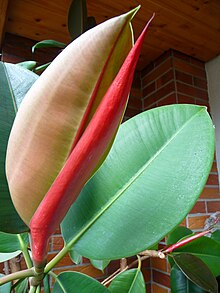Rubber tree
| Rubber tree | ||||||||||||
|---|---|---|---|---|---|---|---|---|---|---|---|---|

Rubber tree ( Ficus elastica ), in its natural location with aerial roots. |
||||||||||||
| Systematics | ||||||||||||
|
||||||||||||
| Scientific name | ||||||||||||
| Ficus elastica | ||||||||||||
| Roxb. |
The rubber tree or Indian rubber tree ( Ficus elastica ) is a species of the fig ( Ficus ) genus , to which the edible figs also belong, in the mulberry family (Moraceae). It is classified in the group of banyan figs , which also includes the poplar fig (banyan tree), which is important in Buddhism .
Ficus elastica has its original home in an area from northeast India ( Assam ) to Indonesia ( Sumatra and Java ). Today, however, it is a widespread houseplant, as well as an ornamental shrub in the tropics and subtropics , which is often planted in parks, gardens, and as a street tree.
Description and ecology

Appearance and leaf
In Ficus elastica is a baumwürgende Hemi epiphyte (strangler fig), an evergreen tree that can reach a stature height of 20 to 40 meters (rarely to 60 meters) and a trunk diameter of up to 2 meters. The bark is light brown to medium brown and smooth. The trunk is irregular and develops aerial roots and buttress roots to anchor it firmly in the ground and to support the heavy branches. Young plants can also be found growing as epiphytes .
When injured, the vegetative parts of the plant give off plenty of white milky sap (latex). Since it can trigger allergic reactions up to anaphylactic reactions for latex allergy sufferers , they should avoid it.
The alternate leaves are divided into a petiole and a leaf blade. The petiole is 2 to 5 cm long. The simple, entire, leathery leaf blade is 8 to 35 inches long and 5 to 15 inches wide. The leaf top is glossy dark green and the leaf bottom is light green. The leaf size is largest in young plants, which naturally have to get along with the little light in the undergrowth (occasionally up to 45 centimeters) and much smaller in older trees. The stipules are fused to a large side sheet that protects the young leaves prior to deployment as a bag. It is usually dark red, about 10 cm long and is shed when the leaf is unfolded. The leaves contain cystolites .
Generative characteristics
Ficus elastica are single sexed ( monoecious ). As with other Ficus species, the flowers require a special kind of symbiotic (obligatory mutualism ) living fig wasps for pollination . Therefore, the rubber tree does not need colored or fragrant flowers to attract pollinators. The flowers are located inside an inflorescence. These inflorescences are formed in pairs axillary on leafless, small branches. They are almost sessile and about 10 × 5 to 8 mm in size. Male and female, of which there are fertile and sterile gallblades, flowers are located in an inflorescence. The stalked male flowers have four sepals and only one stamen without stamen . The sessile female flowers have a long stylus that ends in an enlarged, more or less cephalic stigma. The sterile gallbladder has four sepals and a short, curved style.
The fruit is a small, yellow-green fig, about 1 centimeter long, oval, which is hardly edible. Fertile seeds are only included if the flower has been pollinated by the specific fig wasp.
Chromosome number
The number of chromosomes is 2n = 26, less often 39.
Culture and use
Ficus elastica is used worldwide as an ornamental plant, in warm areas outdoors, in cooler climates as an indoor plant. There are different varieties, including those with brightly variegated leaves, i.e. white-green leaves.
The rubber tree prefers bright sunlight, but can also get by with little light. It is tolerant of drought, but prefers moist soil without waterlogging. It grows particularly well in humid, tropical environments.
This species and its varieties are propagated vegetatively by cuttings or rarely by mossing . Sowing is possible. A tissue culture can be used to fast, large growth rate.
The white milky sap ("latex") that escapes from injuries and contains natural rubber can be used to manufacture rubber. However, practically only the rubber tree ( Hevea brasiliensis ) is used for commercial latex production. The rubber tree is not closely related to this one.
literature
- Zhengyi Wu, Zhe-Kun Zhou, Michael G. Gilbert: Ficus elastica. In: Wu Zhengyi, Peter H. Raven, Deyuan Hong (Eds.): Flora of China . Volume 5: Ulmaceae through Basellaceae . Science Press / Missouri Botanical Garden Press, Beijing / St. Louis 2003, ISBN 1-930723-27-X , pp. 42 (English). , online.
- Hans Jessen, Helmut Schulze: Botany in questions and answers: Over 1300 questions and answers. 15th edition, Schaper, Alefeld-Hannover 2001, ISBN 3-7944-0195-6 , limited preview in the Google book search.
See also
Individual evidence
- ↑ C. Birnbaum, C. Böttger u. a. (Ed.), W. Hamm (author): The chemistry of daily life. 7th edition, 5th volume from the series: The new book of inventions, trade and industries. Springer, 1878, ISBN 978-3-662-33693-9 (reprint), p. 386.
- ↑ Rhett D. Harrison, Kwek Yan Chong, Nguyet Minh Pham et al .: Pollination of Ficus elastica: India rubber re-establishes sexual reproduction in Singapore. In: Scientific Reports. Volume 7, Article number: 11616 (2017), doi : 10.1038 / s41598-017-09873-z .
- ↑ Ficus elastica in Tropicos.org. In: IPCN Chromosome Reports . Missouri Botanical Garden, St. Louis



